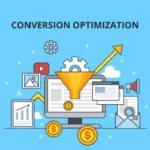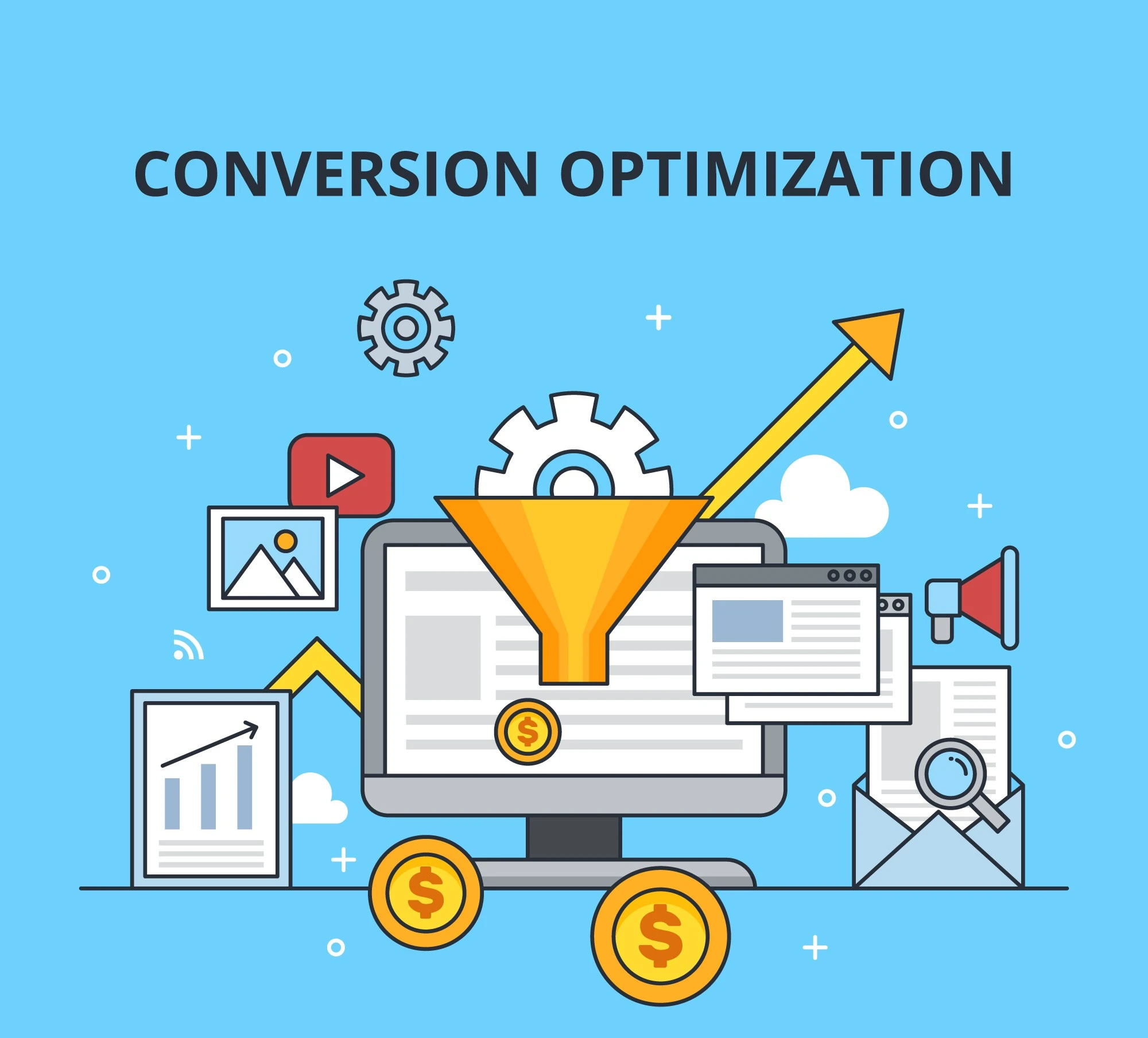Hundreds of visitors a day and only a few pay. Frustrating?
This is the reality for most businesses in today’s online world. Traffic is important but what’s really important is converting that traffic into customers. That’s where conversion rate optimization (CRO) comes.
In this blog we are going to look into everything you need to know to optimize your site and see real results.
What Is Conversion Rate Optimization (CRO)?
Conversion rate optimization (CRO) is the process of making your website persuade visitors to do something – buy, sign up for a newsletter, fill in a form etc.
CRO is about:
- Understanding visitor behaviour through data and tools
CRO starts from the very beginning of the understanding of ways visitors interact with your website. You can use tools such as Google Analytics or Hotjar to provide the relevant knowledge of user behavior that may give you insights about what has worked for them and where they have dropped off.
- Finding the barriers to conversion
You should then identify the conversion barriers, which may include slow page load, unclear CTA, and complicated checkout. They can be analyzed simply by analyzing the visiting numbers knowing the source of traffic on your website.
- Implementing strategies to improve user experience and get people to take action
Strategy can be implemented right away to make the user experiences way better and help with increased conversion rates. For example, improve the navigation, speed up page load, and have clear CTAs. Personalisation of content is also an added advantage alongside quickening the checkout for the new converters.
Why CRO is important for business growth
Not optimizing your website means you are wasting traffic, revenue losses, and opportunities gone by. Every time a visitor visits your site without converting, you end up wasting your efforts and expenses in recruiting traffic. CRO does determine the action taken by more visitors on your site-whether to buy something, subscribe to a service, or engage with your brand.
CRO leads to maximizing every visitor. Thus, better conversions, increased revenue, and improved customer loyalty. It lead to business growth and a competitive advantage in the industry.
The Benefits of CRO:
Increased Sales and Increase in Leads: When you make your well-optimized and visitor-friendly site, it makes converting visitors into customers, thereby meaning increased sales and also more quality leads. Strategies for CRO can improve the website’s ability to entice visitors going for the call to action-whether buying a product or signing up for a service.
Improved Customer Satisfaction: A better, smoother experience while surfing the site usually makes customers much happier. CRO also eliminates the friction points and will reduce the effort needed for the customers to actually find what they want, hence improving overall satisfaction that leads to more repeat purchases and referrals.
More Returns on Investment in Marketing: CRO takes care of ensuring that you utilize the maximum from existing traffic. Rather than spending on more ads or traffic generation, CRO maximizes the results on current visitors and generates high ROI from marketing investments.
Example:
If 10,000 users visit your website per month and your conversion rate is 2% that’s 200 conversions. A 1% improvement gets you 300 conversions, 50% more results without spending more on traffic.
CRO Techniques to Boost Conversion Rates
Data-Driven Insights
CRO depends on analytics tools like Google Analytics, Hotjar, and Crazy Egg to identify user behavior. The results show what works, what doesn’t, and where users fall off, thereby allowing for very precise optimization.
Improved UX
A user journey that is smooth and intuitive brings better conversions. CRO removes all the frictions of slow loading times, unclear navigation, and bad design.
Targeted Strategies for Your Target Audience
Personalization is critical. CRO will utilize audience segmentation to display the appropriate content, offer personalization, and provide navigation customized for every visitor, letting the users feel that the service provider understands them.
Higher ROI on Traffic without Increased Traffic
CRO focuses on improving your conversion of existing visitors to ensure higher revenue and spending less on acquiring leads.
Ongoing improvement with testing
With tools such as A/B testing and multivariate testing. CRO is an ongoing process that refines your strategies to ensure constant improvement in performance over time.
Core Metrics to Track in CRO
Check out these metrics to measure success:
Conversion rate (CR)
Percentage of visitors completing the objective.
Click-through rate (CTR)
It measures how well your CTA and links are working.
Strong bounce rate
Percentage of users visiting only one page.
Customer Lifetime Value (CLV)
The total revenue you can expect from one customer over time.
Order Value (AOV)
It helps to know how much each customer spends.
How to Improve Website Conversion Rates
Optimize Landing Pages
Most times the landing page acts as the first touchpoint for customers with the business. Do the following to ensure it is done well:
- Strong and clear headlines
- Compelling CTAs
- Trust indicators such as surveys, badges, and certifications
- Ensure it is mobile friendly
Price You for Good
Stable investments could easily break customers from wagons. It sounds easy:
- Have fewer steps
- Multiple payment options
- Discounts for guests.
Leverage A/B Testing
Try different things, such as:
- Title cards
- Images
- CTAs, etc.
To see what matches your audience best.
Boost Page Load Speed
Faster websites yield better results. Conversions can drop by 7% with just a one-second delay.
Personalize User Experience
Use information about the consumer to personalize the recommendations or offers he receives.
Common Challenges in CRO (and How to Solve Them)
Most companies have to deal with the challenges of conversion funnel optimization. Here are the solutions:
Bounce Rates
- Solution: Optimize content for relevance.
- Example: An unmistakably seasonal offer like “Shop Now” keeps one of the good things longer around.
Confusing Navigation
- Solution: Simplify the menu and search bar.
- Example: “Men’s,” “Women’s,” “Sale” categories can be browsed easily.
Unclear CTAs
- Solution: Use action-oriented CTAs, like “Buy Now,” or “Learn More.”
- Example:”Schedule a Free Consultation”; this clearly leads a user onto the next action.
Slow Loading Pages
- Solution: Images compress, CDN use increases load times.
- A fast-loading online store turns users into keepers as they spend more time on site.
Not Mobile Friendly
- Solution: Make the design responsive to all screen sizes.
- Example: The mobile restaurant website allows customers to easily book and order.
Key Differences: Conversion Rate vs. Click-Through Rate
Both Conversion Rate (CR) and Click-Through Rate (CTR) rank among the most important metrics but target different phases in the customer’s journey. The following summarizes their difference:
Conversion rate is all about actions taken by the user after they have clicked; that is, purchasing something, signing up for a newsletter, or filling out a contact form. In other words, how many of the visitors, in the end, achieved your desired goal?
Click-Through Rate is how effective your calls to action or ads are at attracting people to take action and click on them. This is a very important metric in analyzing how well you’re guiding traffic along to the next part of the sales funnel.
Example:
You have a campaign that gets 10,000 impressions. It collects 300 clicks, which gives that campaign a 3% CTR. Of these, 30 buyers were made, which results in a 10% conversion rate. This is because although your ad was great at getting clicks, all of those who clicked didn’t purchase.
Good Conversion Rate
Including 2-5% conversion rates is generally considered strong in any industry. This can vary by individual company model, industry and user intent as well. Some examples can be given:
E-Commerce: Online stores may generate conversion rates in the region of 1-2%, though highly optimized stores may reach upwards of those rates with some internal tricks.
Because they deal with long-term relationships, conversion rates for SaaS companies would be closer to 5-7% or even more.
Lead generation sites: Usually, conversion targets in these sites are between 5-10%, which depend on the complexity of the offer.
Applying the effective CRO techniques would increase your conversion rates enormously and also ensure that your CRO strategies for 2025 align well with the customers’ expectations.
Why You Need a CRO Agency
When you partner with a CRO agency like BizClick Digital, they have experts who:
- Perform extensive audits of your website.
- Set up customized solutions in relation to your unique business requirements.
- Track results and tune them continuously for improving performance.
This means that while they take care of all technicalities involved in conversion optimization, they allow you to get focused on the business.
Conclusion: Turn Visitors into Loyal Customers
The importance of optimization to conversion rates is absolutely paramount. Adopting state-of-the-art innovations in CRO and incorporating changes into businesses will be a vital necessity in the year 2025. Growth without more visitors can be achieved through data-informed insights, overcoming barriers, and a seamless and user-friendly experience.
Today, start experimenting and feel the difference in bringing visitors in as their loyal customers!
 logo
logo


